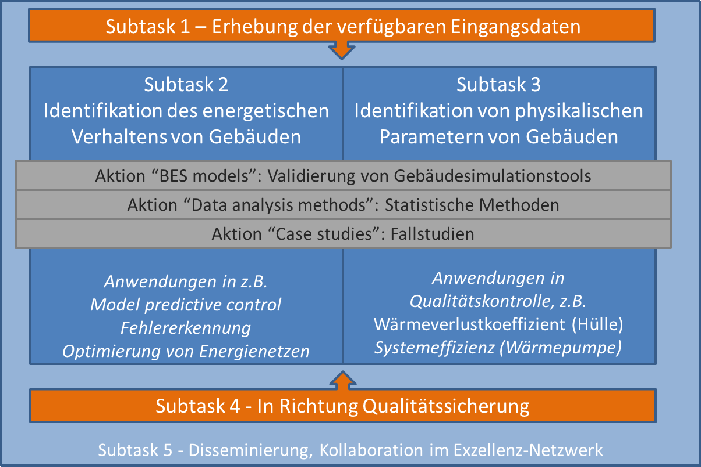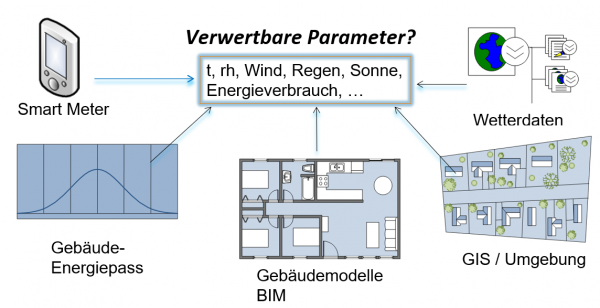IEA EBC Annex 71: Building Energy Performance Assessment Based on In-situ Measurements
Short Description
The aim of the project was to create a methodological basis for an in-situ assessment of the actual energy performance. The project was based on the results of the predecessor project Annex 58. With the help of measurement data from occupied buildings, which are favourably available "anyway", data-driven building models were to be identified in order to be able to predict thermal behaviour and derive energy efficiency parameters for quality assurance. For this purpose, the work was divided into five Subtasks (ST):
- Subtask 1 was dedicated to the collection of the required input data. Here, the Austrian contribution investigated the possibility of collecting and merging "anyhow" existing data from sources such as home automation, smart meters, and building-relevant data bases.
- In Subtask 2, methods for identifying models for predicting the thermal/energy behaviour of buildings were tested and further developed. This is intended to improve applications such as fault detection and model-predictive control. Based on measurement data from accompanying research projects, the Austrian contribution investigated the suitability of different model approaches.
- Subtask 3 investigated the extent to which building models identified from measurement data can be used to characterize the quality of the building envelope. On the basis of various case study objects, different model approaches and their input data were investigated in the international and Austrian part of the project and tested for their practical suitability.
- Subtask 4 dealt with the question to what extent and under which conditions these methods could be suitable for the quality assurance of buildings in practice. For this purpose, a stakeholder survey was conducted amongst other activities.
- Subtask 5 was dedicated to the dissemination of results and the networking of stakeholders.
In addition to the five subtasks, further "actions" were performed to test and compare the suitability and accuracy of the various modelling methods. For example, as in Annex 58, a "blind" validation exercise for building simulation programs was performed. The measurement data generated for this purpose are extensively documented and publicly available. These data will continue to form a valuable basis for model validations in the future.
For the application field "Building behaviour identification", different data-driven building models (from blackbox to greybox) were tested and evaluated. The influence of the available database (data quality and number of features) was also evaluated. The prediction quality could mostly be improved by adding features, whereas data quality and data pre-processing turned out to be important in many cases. The potential of different model approaches could be shown by common exercises for the two applications "fault detection" and "model predictive control". Based on the results of this project, these applications could and should be further developed and tested in real-world applications. They represent a promising tool for a data-driven energetic optimization of building operation and/or for an increased use of renewable energies.
For the application field "Physical parameter identification", an attempt was made to determine the heat transfer coefficient (HTC) of various case study objects. The influence of the different input variables was systematically investigated. Results indicate that the investigated methods would in principle be able to determine the HTC from in-situ measurements with sufficient accuracy (e.g. +/-15%), but the methods do not seem robust enough to perform data-driven building characterization for quality assurance purposes in practice. Further research would be needed to develop detailed guidelines considering case-specific peculiarities. The Austrian contribution, among others, worked in this direction. Here, for example, building models were developed which also use the measured CO2 concentration of the room air in order to better represent the real ventilation behaviour in the model.
Project Images
Terms of use: The pictures listed underneath the header “Project Pictures” originate from the projects in the frame of the programmes City of Tomorrow, Building of Tomorrow and the IEA Research Cooperation. They may be used credited for non-commercial purposes under the Creative Commons License Attribution-NonCommercial (CC BY-NC).
Participants
Austria, Belgium, Denmark, Estonia, France, Germany, Italy, Netherlands, Norway, Spain, United Kingdom
Contact Address
AB Energieeffizientes Bauen, Universität Innsbruck
Gabriel Rojas
Technikertr. 13
A-6020 Innsbruck
E-Mail: gabriel.rojas-kopeinig@uibk.ac.at
Institut für Rechnergestützte Automation, TU Wien
Susanne Metzger
AIT - Austrian Institute of Technology GmbH
Miloš Šipetić





